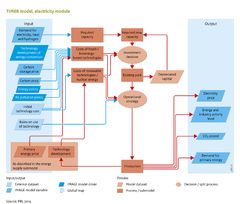Energy conversion/Data uncertainties limitations: Difference between revisions
Jump to navigation
Jump to search
No edit summary |
No edit summary |
||
| Line 1: | Line 1: | ||
{{ComponentDataUncertaintyAndLimitationsTemplate | {{ComponentDataUncertaintyAndLimitationsTemplate | ||
|Reference=Van Vliet et al., 2013; Hoogwijk et al., 2007; Hendriks et al., 2004b; Van Ruijven et al., 2007; | |Reference=Van Vliet et al., 2013; Hoogwijk et al., 2007; Hendriks et al., 2004b; Van Ruijven et al., 2007; WEC, 2010; MIT, 2003; | ||
|Description=<h2>Data</h2> | |Description=<h2>Data, uncertainties and limitations</h2> | ||
===Data=== | |||
The data for the model come from a variety of sources, the main of which are: | The data for the model come from a variety of sources, the main of which are: | ||
| Line 50: | Line 51: | ||
</table> | </table> | ||
==Uncertainties== | ===Uncertainties=== | ||
The two main uncertainties are calculation of future energy conversion relating to development rates of the conversion technologies, and the consequences for the electricity system of a high level of market penetration of renewable energy. | |||
TIMER electric power generation submodule has been tested for different levels of market penetration of renewable energy in the United States and western Europe ([[Hoogwijk et al., 2007]]). The model was shown to reproduce the behaviour of more detailed models that describe system integration costs. More recent studies seem to suggest that some of the limitations in renewable energy penetration can be overcome at reasonable costs, implying the current description is rather conservative. Integration costs for renewable energy are very uncertain because large shares of market penetration still need to be achieved, except in a few countries. In experiments run by The power system was exposed to all types of technology limitations in experiments run by Van Vliet et al. ([[Van Vliet et al., 2013|2013]]). These experiments showed that to achieve low stabilisation targets, a large portfolio of mitigation options should be available. | |||
===Limitations=== | |||
The model describes long-term trends in the energy system, which implies that the focus is on aggregated factors that may determine future energy demand and supply. However in energy conversion, many short-term dynamics can be critical for the system, such as system reliability and ability to respond to demand fluctuations. These processes can only be represented in an aggregated global model in terms of meta-formulations, which implies that some of the integration issues regarding renewable energy are still not addressed. | |||
Another limitation is the formulation of primary fossil-fuel conversions in secondary fuels. TIMER currently does not include a module that explicitly describes these processes. | |||
}} | }} | ||
Revision as of 13:01, 22 May 2014
Parts of Energy conversion/Data uncertainties limitations
| Component is implemented in: |
|
| Related IMAGE components |
| Projects/Applications |
| Models/Databases |
| Key publications |
| References |
